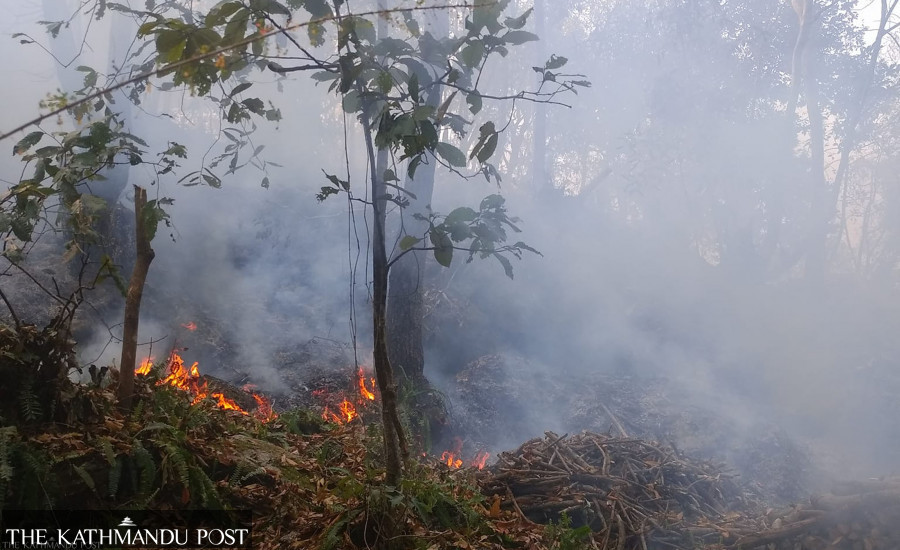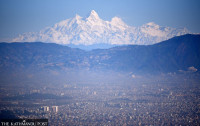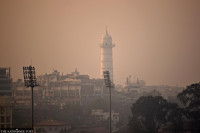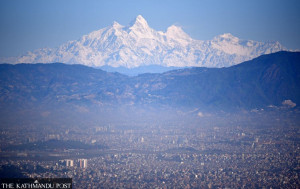Climate & Environment
Dry materials on forest floor and drought are stoking forest fires
Climate change and weakening link between the public and forests due to migration are amplifying risks, experts say.
Arjun Poudel
At least 76 incidents of fire were reported in the last one week, although the exact number of forest fire cases during this period remains unclear. Officials at the National Disaster Risk Reduction and Management Authority (NDRRMA) have reported a marked uptick in forest fire cases nationwide.
What has left officials much concerned now is the lack of rainfall for a prolonged period, which has created drought-like conditions. Experts warn that inaction by stakeholders to take timely mitigation measures could lead to a more disastrous fire season this year.
“Our past data show that major forest fire incidents tend to occur every two to three years,” said Sudip Chhatkuli, undersecretary at the authority. “Accumulation of fuel (dry leaf, dry grass, twigs, branches and trees) for years and dry conditions could ignite major fires in our forests, which will not only destroy forests but also risk lives and human settlements.”
Wildfires are common in Nepal during the dry season. Last year, over 5,125 incidents of forest fires were recorded throughout the country between January 1 and June 24. Seventy-four out of 77 districts reported forest fire incidents. Fourteen districts saw more than 102 forest fire incidents. According to the NDRRMA, Surkhet alone recorded 328 incidents of forest fire.
The years 2009, 2016, and 2021 were particularly catastrophic, when thousands of forests burnt in what officials termed ‘disastrous years’.
“We only start talking about forest fires after they have already broken out,” said Sundar Sharma, a forest fire expert. “This time also, forest fire season has started, and we are asking if we have taken any preventive measures.”
Nepal’s valuable forests which took more than six decades of efforts to restore, are facing a worsening wildfire reality, compounded by scarce resources and nearly zero strategies to prevent or contain them.
The country has increased its forest coverage from around 41 percent to 45 percent. However, several factors, including the direct impact of climate change and weakening relationship between the public and forests, have led to a rise in the number of forest fire incidents each year.
“Rainfall patterns have changed, and it has already been months since winter rainfall occurred,” said Bhusan Tuladhar, an environmentalist. “People are migrating to cities and abroad in search of better opportunities, which means they and their family members are less dependent on the forests than before and this is complicating forest protection efforts.”
Experts argue that when people do not collect fodder, firewood, wood, and other materials, these things pile up on the forest floor and turn into fuel for fires during the dry season. Forest fires not only destroy forests but also pose a serious threat to humans lives, wildlife, and property.
“We have only been talking about preserving forests, but now it is time to learn how to protect our valuable forests more scientifically and maximise their benefits for the public,” said Tuladhar. “We must explore ways to reduce the risk of forest fires, utilise forest products for the greater good of the public, and make better use of our resources.”
Experts suggest that raising awareness about the consequences of deliberately starting forest fires and penalising those involved could make a huge difference in reducing fire incidents.
Strengthening local governments, imparting training to locals, providing them with the necessary tools to deal with possible fires, and building artificial ponds are among the measures recommended to manage fire incidents.
Experts also advocate for exploring early warning systems, launching public awareness campaigns, giving fire-fighting training, providing fire fighting equipment, including water pumps, and making fire lines as effective ways to mitigate the impact of forest fires.




 9.12°C Kathmandu
9.12°C Kathmandu











